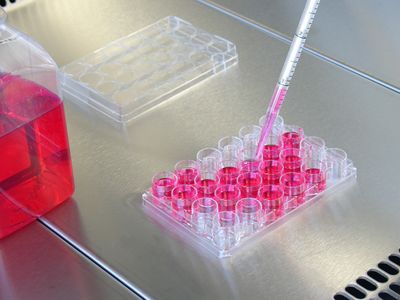Mass photometry is a technique that uses light to determine the mass of proteins and other biomolecules. When light shines upon amino acids, some of it is deflected in a process known as scattering. The amount of light that scatters is proportional to the number of amino acids present. So, scientists can determine the mass of a protein by measuring the interference between the light scattered by the molecule and the light reflected at the measurement surface. Moreover, the same logic applies to other biologically-related particles, including nucleic acids, vesicles, micelles, and synthetic polymers. Mass photometry is accurate, capable of measuring the mass of a protein to within 2 percent of its true mass. It also possesses a broad dynamic range, spanning two orders of magnitude from tens of kilodaltons to megadaltons. This size range encompasses proteins, protein complexes, DNA, RNA, plasmids, macromolecular complexes, nanostructures, and small viruses such as adeno-associated viruses (AAVs).
Mass photometry is easy to perform, requiring as little as 10 µL of sample volume per measurement. Further, the technique is performed on samples in solution, with no protein modifications or labeling required. This allows researchers to investigate protein properties and behavior in an environment that closely mimics the composition and chemistry of biological fluids such as the cytosol. It also makes the technique exceptionally suited for monitoring dynamic interactions, such as binding kinetics, responses to environmental shifts, and multi-step complex formation mechanisms.
Looking at Proteins from Multiple Angles
Given its properties, researchers use mass photometry for many different purposes. The technique is often used to characterize particle mass distribution within samples. This data is particularly important for quality control purposes, as it offers information on sample purity and homogeneity/heterogeneity. Researchers can also use mass photometry to verify sample suitability for downstream applications—for example, to check for protein aggregation in cryo-electron microscopy samples.1 Particle mass distribution data can also provide information on oligomerization status and dispersity. Is a given protein naturally monodisperse—uniform in particle size and distribution—or polydisperse? Does it exist as a monomer? A dimer? A trimer?2
Scientists also employ mass photometry to examine biomolecular interactions, whether protein-protein or protein-DNA, as binding will result in the formation of a complex with greater mass.3 Similarly, it also allows researchers to investigate complex assembly and disassembly kinetics. For example, some have utilized mass photometry to analyze binding stoichiometries between different haptoglobin oligomers and hemoglobin.4 Finally, mass photometry is advantageous for studying lipid-bound proteins, such as those attached to cell surface membranes, because it can detect particles within a detergent-containing solution.5 Because mass photometry does not require labels, it offers a thorough detection of all of the particles within a sample, thereby generating more comprehensive data.6,7
Bringing Mass Photometry to the Lab
Incorporating mass photometry into one’s research means finding the right instrument. Mass photometers from Refeyn deliver speed, sensitivity, and simplicity. Their flagship instrument, the TwoMP, is easy to set up and operate, and it fits easily on a lab bench. The TwoMP Auto is capable of automation, enabling the rapid measurement of up to 14 samples in an hour with minimal user intervention. Finally, the SamuxMP is a mass photometer specifically designed for AAV development and quality control, reporting empty/full capsid ratios for AAVs of any serotype within five minutes per sample. All Refeyn mass photometers are driven by easy-to-learn software specifically tailored to each specific instrument model, including the AcquireMP and DiscoverMP software suites for data acquisition and analysis.
References
- R.J. Harding et al., “Huntingtin structure is orchestrated by HAP40 and shows a polyglutamine expansion-specific interaction with exon 1,” Commun Biol, 4:1374, 2021.
- G. Ofir et al., “Antiviral activity of bacterial TIR domains via immune signalling molecules,” Nature, 600(7887):116-20, 2021.
- F. Soltermann et al., “Quantifying protein-protein interactions by molecular counting with mass photometry,” Angew Chem Int Ed Engl, 59(27):10774-79, 2020.
- S. Tamara et al., “A wealth of genotype-specific proteoforms fine-tunes hemoglobin scavenging by haptoglobin,” PNAS, 117(27):15554-64, 2020.
- “Mass photometry with detergents [Application note]”, Refeyn.
- E.D.B. Foley et al., “Mass photometry enables label-free tracking and mass measurement of single proteins on lipid bilayers,” Nat Methods, 18:1247-52, 2021.
- A. Olerinyova et al., “Mass photometry of membrane proteins,” Chem, 7(1):224-36, 2021.





